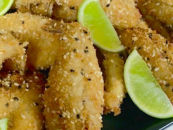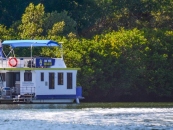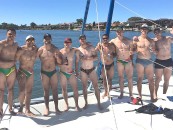The Australian east coast is one of the most scenic travel destinations in the world. It is also the place where I was lucky enough to grow up. With a keen interest in everything related to the ocean, I have been fortunate enough to sail along the New South Wales and Queensland coasts.
THE VESSEL: MALAIKA
During the early years, my family worked on a 10- year project of building a homemade 15m steel motor-sailor yacht from scratch. This was born out of my dad’s crazy dream of truly self-sufficient sailing. We all surrendered to the cause and dedicated a lot of time to building Malaika.
After 10 years of hard labour and dedication, my dad’s dream became a reality. In 2014, Malaika wet her keel for the first time in the channels of Gosford. Consequently, the next few years would be spent exploring the surrounding coastline while teaching ourselves how to sail.
BASIC SAILING TIPS
If you are dreaming of a lifestyle change or just an epic coastal sailing adventure, this story is a quick guide that might help new cruisers and sailors wondering about what it is like sailing up the east coast of Australia, from Brisbane to Cairns, through the eyes of a novice sailor. These words are a reflection of
my personal experiences and what I have learned sailing. Along the way, I strive to capture images that tell a story and captivate those with a connection to travel and adventure. Here are some general tips to help you out on your cruising journey.
Take Your Time – This is probably the most important rule of all. Heading out into dangerous seas just for the sake of moving to the next destination is counterproductive and dangerous. Sailing teaches you patience. If conditions are bad, you are going to regret leaving port as soon as you get out.
Remember, Weather Is King – Every sailor knows that they cannot beat the sea. Make sure to always check weather conditions and forecasts before you leave port. It is also a good idea to recheck just before you leave, as conditions could have changed since the forecast during the night before. While conditions might seem calm and relaxed in a quiet anchorage, winds might be howling and swell might be pumping just around the headland.
Buy Alan Lucas’ Cruising Books – He is known as the “lord of the sandflies”. After you read some of his guides, you will quickly understand why. He seems to love anchoring on creeks and rivers that are full of sandflies. Still, his books are the best and most comprehensive guides you will find for anchorage information and channel crossings. The books are a little hard to find online, but you will definitely want a copy onboard.
Invest in Electronic Equipment – There are plenty of good cruising books and online resources that go into detail about equipment. Therefore, I will not elaborate on what kind of equipment you are going to need. However, here are some things that you will definitely want with you:
– A good chart plotter.
– An autopilot (unless you want to spend tireless days and nights at the helm)
– Solar and inverter charger and deep-cycle batteries
– Depth and wind gauges
Avoid Cyclone Season – In the Queensland region, tropical cyclones can form from lows within the monsoon trough. Sailing in Far North Queensland during the months between November and April is generally discouraged. Many full-time cruisers instead choose to head south to NSW during this time of the year. This is convenient because the south-easterly trades die off during this time, making sailing south much easier.
Avoid Sailing Against The Trades – One of the biggest tips is to plan your trip sailing up the east coast, especially in Queensland, to run with the trades. While it might not always be favourable, it is a much better idea to either put it off or go sooner in order to catch the right season. The East Coast Trades, especially further up the coast, are pretty reliable for running north. In Queensland, the trade winds blow in an east-to-southeast direction from April to November. During this time, it is a breeze sailing up the coast, as you will be running most of the time.
General Access to Provisions, Water and Fuel – Cruisers will be able to have access to provisions, water, and fuel almost everywhere up the coast. Water is generally free, and safe to drink from the docks. Diesel and fuel is also readily available at most marinas and, of course, you should expect to pay a premium for the convenience of refuelling at the dock.
Cost of Full-time Cruising – Full-time cruising in Australia can get pretty expensive. However, if you catch your own fish, use the wind for momentum and mostly anchor for free, then that cost is much less than living on land. The main daily costs will be diesel and food, and amounts will vary depending on your appetite and how much you run your engine. Treat yourself well as often as you can afford, by docking at marinas where you can expect to pay between $70 and $140 per night.
And, remember how the saying goes: “The sailor who claims to never have boat problems has never left the harbour.” Always consider the risk of having to pay for repairs. Every boat has problems, from the engines to sails, electronic equipment to leaks.
Internet When Sailing – By far, the best reception you will get when sailing the east coast of Australia is with Telstra, but it is definitely going to be spotty. You will generally have better connections closer to land and closer to major cities. Between Fraser Island and Mackay is a huge section where you will get absolutely no service. Remember to plan ahead and prepare to use the radio during this part of the sail.
SOME AMAZING EXPERIENCES
So, tips and technicalities aside, here are a few of the great things that you may experience sailing up the east coast.
Dolphin Greetings – Dolphins are an incredible animal. You will often find them “playing” with your vessel by dancing and jumping along the wake and at the bow. You will probably meet many pods along the way, but the highest concentration of dolphin populations tend to hang around the Newcastle Coast in NSW.
Fishing and Trolling – When we sail and cruise, we generally always have a trolling line out. I am probably not the best person to comment on fishing. However, we caught plenty of mackerel trolling with deep-diving lures, especially north of Brisbane. It seemed to us the further up the coast you sail, the better the fishing gets.
Humpback Whale Migration – Every year, approximately 60,000 humpback whales leave Antarctica and make their own journeys north. It is the biggest mammal migration in the world, and it takes them three months to reach northern Australia. Here, they mate and nurture newborns in the warm tropical waters. Whales head north from July to September, and they head south from September to January. If you are sailing up the coast during the whale migration, then you will almost certainly come across more than a few. This can be a blessing and a curse. Sailing at night time can be risky, as the huge mammals sleep on the surface, completely oblivious to cruising vessels. Many people have reported “bumping” whales when sailing up the coast; not a pleasant experience for you, and certainly not for the whales.
Abandoned Resorts – Beginning as far south as the Whitsundays are the relics of Australia’s once- booming island tourism industry. Unfortunately, many of the island resorts that you will find sailing up the coast are now abandoned. Some theories on why this is so include the high cost of travel in Australia compared to overseas travel, as well as the threat of tropical cyclones in the north. Nevertheless, you will get to experience islands that have been cut off to the land-dwelling public for centuries. If the resorts are open, be sure to stop over and show your support, as most are very welcoming of passing boats.
Sharks and Crocs – If there is saltwater, there will be sharks. But, did you know that more people die each year in Australia from cows than sharks? So, do not fear. Generally speaking, sharks do not care for the taste of human flesh. When sailing, you will probably see the occasional fin on the surface. There are also plenty of reef sharks further up north on the reef that are epic to snorkel with. The only exception I found was at Cid Harbour, where several people have been attacked recently. This was the only place I saw where they did not recommend swimming due to the threat of sharks.
When it comes to crocs, on the other hand, I do not share the same confidence. We did not see too many when sailing up the east coast, but they can be seen as far south at Gladstone. Remember to always be croc-safe. I would not recommend swimming in any saltwater mangrove rivers in north Queensland.
CRUISING AND ISLAND-HOPPING
While rivers and creeks can provide some well- deserved calmness, island hopping is where it is at. And the best islands can be found in Queensland.
The most enjoyable part of sailing the east coast is the places where you stop. Below is a list of some of my favourite anchorages and mooring locations that we stopped at during our recent coast trip.
● South Whitsunday Islands (Keswick, Brampton, Outer Newry, Goldsmith)
● Airlie Beach, South Molle Island (Whitsundays)
● Whitehaven Beach, Hamilton Island, and Cid Harbour (Whitsundays)
● The Low Isles (Port Douglas)
● Great Barrier Reef Cays
● The Hinchinbrook Channel
● Magnetic Island (Townsville)
● Orpheus Island
● Green Island (Cairns)
● Dunk Island, Mission Beach
MUST-HAVE CRUISING AND SAILING APPS
ZULU WATERWAYS – This is a useful app that allows users to share data about waterways and anchorage locations.
NAVIONICS – Navionics is our go-to map provider. We use it on our chart plotter and apps on mobile and tablet. The app also allows for user input to share information about anchorages and moorings, as well as other notable information. Their maps are about as accurate as you can get. In saying that, sometimes all maps can be completely off.
WILLY WEATHER – Willy Weather uses up-to-date weather information from the Bureau of Meteorology. We use this app for wind, swell and tide data.
RECOMMENDED BOOKS
If you are thinking about sailing up the east coast of Australia, then you will have plenty of days doing absolutely nothing. I understand that this is appealing to many people, but still, you are going to want to keep yourself busy somehow.
● The Sailing Bible: The Complete Guide for All Sailors from Novice to Experienced Skipper (2nd edition)● Diesel Troubleshooter For Boats (Boat Maintenance Guides, Book 3)
● How To Not Buy a Yacht (Sailing Nandji Book 1)
If you are running out of book space in the galley, I would recommend buying a Kindle, since you can keep thousands of ebooks on one device.
To read more about Olly Gaspar and his amazing world travels, visit his great online resource at www.weseektravel.com
By Olly Gaspar
CLICK HERE View Gallery of Images
Published in the August – November 2020 print edition.






























